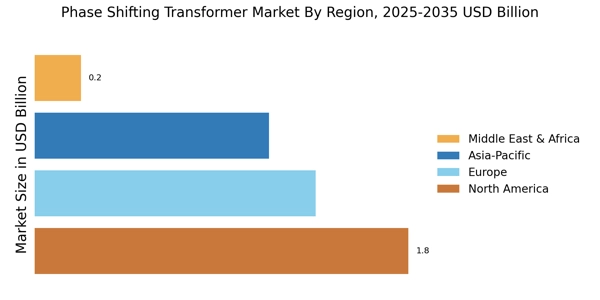Rising Demand for Efficient Power Management
The Phase Shifting Transformer Market is experiencing a notable increase in demand for efficient power management solutions. As energy consumption continues to rise, utilities and industries are seeking technologies that can optimize power flow and reduce losses. Phase shifting transformers play a crucial role in this context, enabling better control of power distribution and enhancing grid stability. According to recent data, the market for phase shifting transformers is projected to grow at a compound annual growth rate of approximately 6% over the next few years. This growth is driven by the need for improved energy efficiency and reliability in power systems, making phase shifting transformers an essential component in modern electrical infrastructure.
Growing Investment in Smart Grid Technologies
Investment in smart grid technologies is significantly influencing the Phase Shifting Transformer Market. As countries strive to modernize their electrical grids, the integration of advanced technologies becomes imperative. Phase shifting transformers are integral to smart grids, facilitating real-time monitoring and control of power flows. This technology not only enhances the efficiency of energy distribution but also supports the integration of renewable energy sources. Recent reports indicate that the smart grid market is expected to reach a valuation of over 100 billion by 2026, with phase shifting transformers being a key element in achieving these advancements. The synergy between smart grids and phase shifting transformers is likely to drive further growth in this market.
Increased Focus on Renewable Energy Integration
The Phase Shifting Transformer Market is significantly impacted by the increasing focus on integrating renewable energy sources into existing power systems. As nations commit to reducing carbon emissions, the demand for technologies that facilitate the smooth incorporation of renewables, such as wind and solar, is rising. Phase shifting transformers enable utilities to manage the variability of renewable energy generation, ensuring a stable and reliable power supply. Market analysis suggests that the renewable energy sector is expected to grow substantially, with investments projected to exceed 1 trillion by 2030. This trend underscores the importance of phase shifting transformers in supporting the transition to a more sustainable energy landscape.
Regulatory Frameworks Promoting Energy Efficiency
The Phase Shifting Transformer Market is benefiting from regulatory frameworks that promote energy efficiency and sustainability. Governments worldwide are implementing policies aimed at reducing energy consumption and enhancing grid reliability. These regulations often encourage the adoption of advanced technologies, including phase shifting transformers, which are designed to optimize power flow and minimize losses. As a result, utilities are increasingly investing in these transformers to comply with regulatory standards and improve operational efficiency. Recent legislative measures indicate a growing commitment to energy efficiency, which is likely to bolster the demand for phase shifting transformers in the coming years.
Technological Innovations Enhancing Transformer Performance
Technological innovations are playing a pivotal role in shaping the Phase Shifting Transformer Market. Advances in materials science and engineering have led to the development of more efficient and reliable transformers. These innovations not only improve the performance of phase shifting transformers but also reduce maintenance costs and extend their operational lifespan. The introduction of smart technologies, such as IoT-enabled monitoring systems, further enhances the functionality of these transformers, allowing for predictive maintenance and real-time data analysis. As the market evolves, the continuous improvement of transformer technology is expected to drive growth and adoption, positioning phase shifting transformers as a vital component in modern power systems.


















Leave a Comment